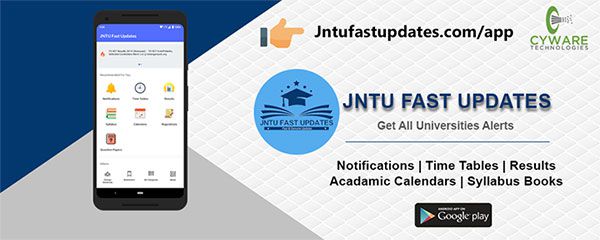JNTUK R20 2-2 Digital Electronics Material/Notes PDF Download
Students those who are studying JNTUK R20 EEE Branch, Can Download Unit wise R20 2-2 Digital Electronics (DE) Material/Notes PDFs below.

JNTUK R20 2-2 Digital Electronics Material/Notes PDF Download
Preamble: This course covers the topics related to representation numbers in different radix formats, complements and codes. It also introduces the basic gates and their realization in SOP and POS form. Boolean algebra and various logic gates minimization process is introduced. Design principles of combinational and sequential circuits are explained to make the students thorough in design of these circuits.
OBJECTIVES:
- To solve a typical number base conversion and analyze new error coding techniques.
- Theorems and functions of Boolean algebra and behavior of logic gates.
- To optimize logic gates for digital circuits using various techniques.
- To understand concepts of combinational circuits.
- To develop advanced sequential circuits.
UNIT-1
Review of Number Systems & Codes: Representation of numbers of different radix, conversion from one radix to another radix, r1’s complements and r’s complements of signed members. Gray code,4 bit codes; BCD, Excess-3, 2421, 84-2-1 code etc., Error detection & correction codes: parity checking, even parity, odd parity, Hamming code
Boolean theorems and logic operations Boolean theorems, principle of complementation & duality, De-Morgan theorems. Logic operations; Basic logic operations -NOT, OR, AND, Universal Logic operations, EX-OR, EX-NOR operations. Standard SOP and POS Forms, NAND-NAND and NOR-NOR realizations.
Download UNIT-1 Material PDF | Reference-2 | Ref-3
UNIT-2
Minimization Techniques: Minimization and realization of switching functions using Boolean theorems, K-Map (up to 6 variables) and tabular method.
Download UNIT-2 Material PDF | Reference-2
Combinational Logic Circuits Design: Design of Half adder, full adder, half subtractor, full subtractor, applications of full adders; 4- bit adder-subtractor circuit, BCD adder circuit, Excess 3 adder circuit and carry look-a-head adder circuit
Download UNIT-2 Material PDF | Reference-2
UNIT-3
Combinational Logic Circuits Design Using MSI &LSI: Design of encoder, decoder, multiplexer and demultiplexers, Implementation of higher order circuits using lower order circuits. Realization of Boolean functions using decoders and multiplexers. Design of Priority encoder, 4-bit digital comparator and seven segment decoder
Introduction of PLD’s: PLDs: PROM, PAL, PLA -Basics structures, realization of Boolean functions.
Download UNIT-3 Material PDF | Reference-2
UNIT-4
Sequential Circuits I
Classification of sequential circuits (synchronous and asynchronous) , operation of NAND & NOR Latches and flip-flops; truth tables and excitation tables of RS flip-flop, JK flipflop, T flip-flop, D flip-flop with reset and clear terminals. Conversion from one flip-flop to another flip-flop. Design of ripple counters, design of synchronous counters, Johnson counter, ring counter. Design of registers – Buffer register, control buffer register, shift register, bi-directional shift register, universal shift register.
Download UNIT-4 Material PDF | Reference-2
UNIT-5
Sequential Circuits II
Finite state machine; state diagrams, state tables, reduction of state tables. Analysis of clocked sequential circuits Mealy to Moore conversion and vice-versa. Realization of sequence generator and sequence detector circuits, Races and Hazards.
Download UNIT-5 Material PDF | Reference-2
TEXT BOOKS:
- Switching and finite automata theory:ZviKohavi, Niraj K. Jha,Cambridge University Press, 3rd Edition, 2009.
- Digital Design by Morris Mano, Prentice Hall India, 5th Edition
REFERENCE BOOKS:
- Digital Principles and Applications by Leach , Malvino , Saha, Mc-Graw Hill, 8th Edition, 2014.
- Switching Theory and Logic Design by A. Anand Kumar, PHI learning, 3rd edition.
- Introduction to Switching Theory and Logic Design – Fredriac J Hill, Gerald R Peterson, 3rdEdition, John Willey and Sons Inc,
- Fundamentals of Logic Design by Charles H. RothJr., Cengage Learning, 7th edition, 2013.
Web Links:
1. Lecture1 – Introduction to Digital Circuits
2. Lecture series on Digital Circuits & Systems by Prof.S.Srinivasan, Department of Electrical Engineering, IIT Madras.For more details on NPTEL visit http://nptel.iitm.ac.in
3. Lecture – 6 Boolean Algebra
4. Basic Logic Gates, Introduction to Logic Gates, Logic Gates Truth Tables
OUTCOMES:
- classify different number systems and apply to generate various codes.
- use the concept of Boolean algebra in minimization of switching functions
- design different types of combinational logic circuits.
- apply knowledge of flip-flops in designing of Registers and counters
- the operation and design methodology for synchronous sequential circuits and algorithmic state machines.
- produce innovative designs by modifying the traditional design techniques.

320-x100(1).gif)

Any 3 easy units in digital electronics